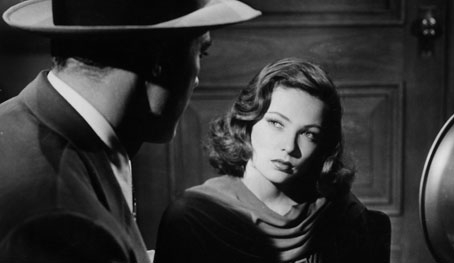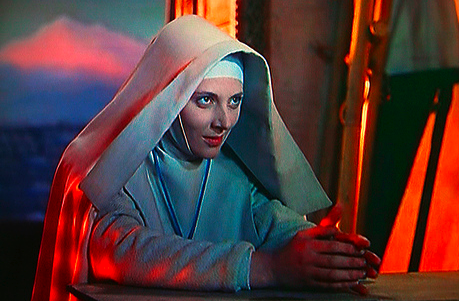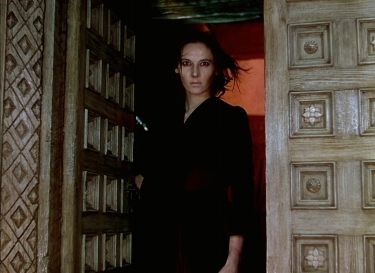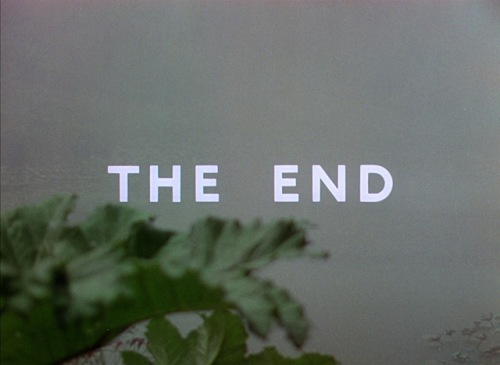The 8th annual TCM Classic Film Festival is coming to a close, and what a weekend it’s been. When I return home tomorrow I will write a wrap-up post summarizing my experience, but I would be remiss if I didn’t write a post today discussing the nitrate prints that festivalgoers were treated to at the Egyptian Theatre these past few days.
Nitrate film stock is known for the shimmering quality it lends to the picture, and for its unique accentuation of line, shadow, and light. It was used in the film industry through 1952, and then due to safety issues owing to its extreme flammability (it holds its own source of oxygen, and keeps burning when thrown in water), it was no longer produced. Many nitrate films were destroyed when the stock went out of production, but we’re lucky that many were also rescued. When one watches a nitrate film, one is essentially watching an “original,” the film equivalent of holding an original photograph. Very few theaters are licensed to show nitrate nowadays, because of the heightened risk of fire. In the Bay Area, where I live, only the Stanford Theater in Palo Alto is equipped to show it.
Going into the festival, one of my most anticipated screenings was Black Narcissus (1947) on nitrate. One of the most beautifully photographed movies of all time, with some of the most vibrant colors we’ve ever seen on film, I knew that it was going to be a magnificent viewing experience. What I was not particularly prepared for, however, was Laura (1944).
I debated whether or not I should go to Laura. It was programmed opposite Twentieth Century, one of my all-time favorites starring one of my all-time favorite actresses, Carole Lombard. It pained me to choose, but ultimately I decided that nitrate needed to take priority.
I’ve seen Laura many times, but was not prepared for what happened when I saw when Gene Tierney onscreen. The nitrate accentuated the lines and shadows of her face, her big, expressive eyes, and the porcelain skin under her jet-black hair. Tierney, whom I consider to be one of the most beautiful faces ever to grace the screen, was so exquisite on nitrate that tears fell from my eyes.
I must stop for a moment to discuss the print. I had a discussion with a few people afterward who were distracted by the pops and scratches on the nitrate print, which had come from the Academy as a “for your consideration” copy for the 1945 Academy Awards. The print did pop and some key lines were covered up. For me, that didn’t matter. We were there (at least I was there) to get the visual of the nitrate. Granted, I have seen this movie before and don’t necessarily need to hear the lines, but I came up with this comparison. When you look at an antique, made by a prominent designer who is known for a certain style, you don’t factor in the fact that it might have scratches on it in your analysis of the style. You look at the style in and of itself, and while the scratches might be an inconvenience, it’s really not what you’re there to look at. That’s my view of the nitrate print of Laura. I saw what I was looking for, and the rest came with the territory of looking at an old film.
With Black Narcissus, none of this was an issue. The print was beautiful, the nitrate was beautiful. Black Narcissus is a movie that has sent a chill up my spine since the first time I saw it. The story of British nuns trying to run a convent in the Himalayas, dealing with cultural differences and a dangerously unstable member of their order, the photography is breathtaking, and the ending is, to this day, considered to be one of the scariest moments in the history of British cinema.
One of the standout nitrate moments for me in Black Narcissus were when Deborah Kerr’s character, Sister Clodagh, has a flashback to when she was a young girl in love in her native Ireland.
The sparkling of the sea in the background, combined with the lines in Deborah Kerr’s hair and the serene, muted colors, brought me to tears during this scene.
The frightening penultimate scene of the movie became even scarier, if that’s possible, as the nitrate highlighted the character’s gaunt, red-tinted eyes and sick pallor.
And finally, at the end, the shot of the green leaves as the rain falls on them.
If you have never seen a film on nitrate, you owe it to yourself to find a theater near you that screens nitrate film. Or better yet, come to the TCM Classic Film Festival next year. There are only a select few theaters in the country that have a license to show nitrate, and The Egyptian Theatre’s retrofit to nitrate capabilities means that the TCM Festival will likely be showing nitrate from now on. It is one of the greatest filmgoing experiences you can have.
I’ll wrap up after I return home tomorrow. See you then, and thanks for reading!






































_03.jpg)

